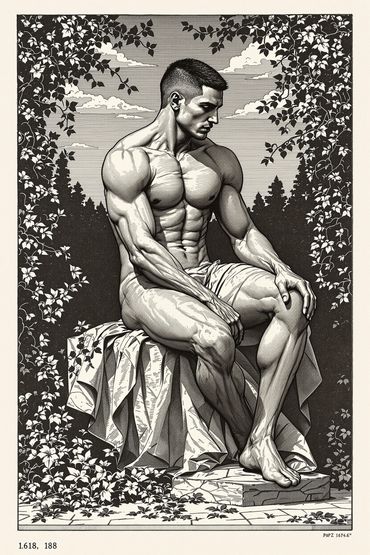Stylus: digital engraving studies

This series explores the visual language of etching and engraving — mediums rooted in incision, resistance, and the slow accumulation of line. First developed in the 15th and 16th centuries, these printmaking methods once required hand-cut copper, end grain blocks, acid baths, and the rhythmic pressure of a printing press. Here, those same effects are achieved not with metal, wood, or ink, but with prompt engineering. Each image was created using artificial intelligence, mimicking the gestures of the engraver’s hand: cross-hatching, stippling, drypoint burrs, and burin-sharp contours rendered with uncanny precision. The colour palette is restrained — black line on aged, off-white ground — yet these are not historical prints. They are digital simulations, composed entirely through language.
Two motifs recur throughout the series: the stylised male figure and the ornate botanical still life. The figures are calm and sculptural, echoing classical studies of anatomical perfection. The flowers are wild, abundant, and intricately composed. Their pairing is deliberate. Flowers to balance the boys. This is not sentimentality, but structure — a visual equilibrium between discipline and abundance, anatomy and ornament. Not a softening, but a symmetry. A rhythm between masculinity and sensuality, structure and excess.
There are flaws — but they are instructive. AI often adds an extra finger or toe, a byproduct of how machine learning models generate images: not by understanding anatomy, but by predicting pixel relationships from vast training data. These hallucinations, though anatomically incorrect, become part of the work. In a medium defined by surface noise and manual imperfection, such errors are absorbed like slips in a worn copper plate or miscuts in a block. The illusion holds. There is no copper, no wood, no acid, no ink — but something essential remains: the sense of pressure, of gesture, of the mark made permanent. Stylus asks what it means to simulate incision without a blade, to recreate the trace of the hand — using a hand that doesn’t exist.




“Technique is just a means to arrive at a statement.” — Jackson Pollock
Copyright © David Name 2025.
All rights reserved.